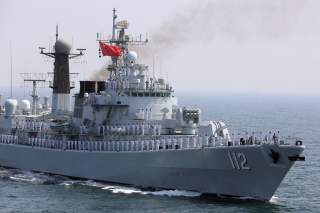China's Power Is Growing in the Indian Ocean
If the Maldives kicking out the Indian helicopters are any indication, Chinese influence has grown since — if at least in relative terms as India’s presence deteriorates.
Two helicopters sit between Asia’s two great powers. India is fast approaching a deadline to withdraw HAL Dhruv utility helicopters from the Maldives, which appears to be the result of mounting pressure from China.
While the helicopters may seem insignificant, a withdrawal would be another sign of India’s declining influence in the island chain, and coming soon after India weighed a military intervention there, and as China muscled its way around the Indian Ocean with a display of warships.
The Indian military has two Dhruvs in the Maldives, six pilots and a dozen technicians servicing the machines. While useful as reconnaissance and search and rescue helicopters, they are also a link between the two governments.
One helicopter — which Maldives wants out — is based in the southern islands which comprise Addu City, where China is building a port. The second is in the less-populated Laamu island chain, but the Maldives is not extending the visas for the 18 Indian crew members that comprise the contingent. In between the two bases is the Huvadhu Kandu or what the U.S. military calls the “One and Half Degree Channel,” a major international shipping passage.
Recommended: How the Air Force Would Destroy North Korea
Recommended: 10 Reasons No Nation Wants to Fight Israel
Recommended: North Korea Has Underground Air Bases
These helicopters are on their way out as Chinese money pours in.
The Maldives, an archipelago state stretching more than 500 miles in the central Indian Ocean, is the recipient of hundreds of millions of dollars in Chinese investments including a bridge between two islands, an airport expansion, a 50-year-lease on the uninhabited touristy island of Feydhoo Finolhu, resort developments, solar energy and thousands of homes — along with an “airport economic zone” in Hulhumale, a quick hop from the country’s capital at Male.
This fits within China’s larger economic designs in the Indian Ocean, the informally-named “string of pearls” of ports, airports and economic investment stretching from the South China Sea to Pakistan. These projects allow China to increase its presence along the region’s key sea lines of communications — or SLOCs — while guaranteeing China’s access to developing markets and international trade.
This is not just an economic strategy, as there are military implications.
In January 2018, a Chinese naval flotilla appeared in the Indian Ocean — the first time in four years — just as India moved aircraft and ships southwards and weighed intervening in the archipelago during an eruption in the country’s political crisis. The Chinese flotilla included the Type 52D destroyer Changsha, the Type 54 Hengyang frigate, the replenishment ship Luomahu and the transport dock Jinggangshancapable of moving marines from ship to shore.
Maldivian Pres. Abdulla Yameen soon declared a state of emergency, part of an increasing concentration of power that has sparked violent protests. Yameen has arrested top judges, arrested opposition figures and forced the country’s first democratically-elected president, Mohamed Nasheed, into exile.
“Just has been the case in other small and poor nations where China has exercised its geo-economic clout over in recent years, it seems that the Maldives is on the verge of conceding its sovereignty to Beijing as a direct consequence of Chinese business taking advantage of the economic opportunities present in the small island country,” Robert Manning and Bharath Gopalaswamy observed in Foreign Policy.
Yameen has held on to power. The Chinese flotilla may have helped — signaling to India that if it intervened to depose Yameen, it would have to deal with Beijing as well. China denied any ulterior motives in the naval demonstration. “These drills were normal exercises for this year and not aimed at any third party,” the Chinese Ministry of Defense stated at the time.
If the Maldives kicking out the Indian helicopters are any indication, Chinese influence has grown since — if at least in relative terms as India’s presence deteriorates.
This first appeared in WarIsBoring here.

